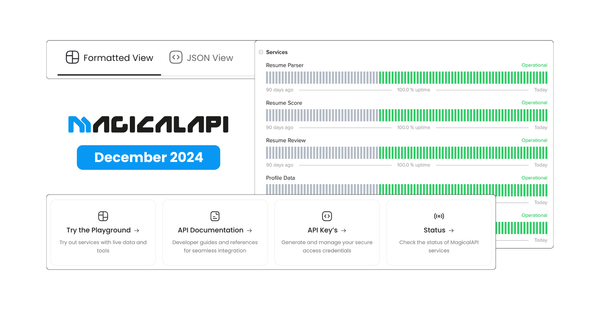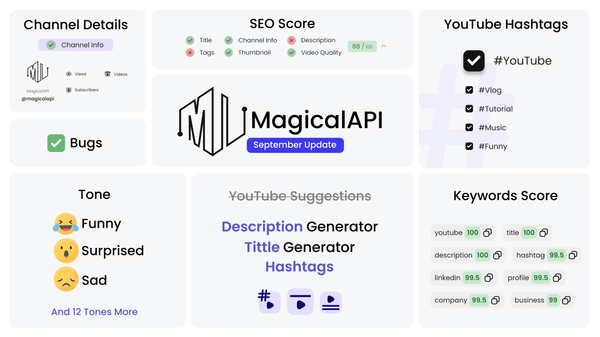Top Benefits of Scraping LinkedIn Data for Small Businesses
Learn how small businesses can leverage LinkedIn data scraping to boost lead generation, recruitment, and competitive analysis.

In today's world, having the right information is crucial, and scraping data from LinkedIn can give small businesses a significant advantage.
This process involves collecting useful information from LinkedIn, which can help businesses understand market trends, learn about competitors, and find potential customers more accurately.
By using this data, businesses can make better decisions, improve their marketing strategies, analyze competitors more effectively, and attract top talent.
✨ Unleash the Power of AI with MagicalAPI!
Whether you’re optimizing YouTube content, extracting LinkedIn data, or evaluating resumes, MagicalAPI is your one-stop solution! Discover the diverse range of AI services tailored to meet your every need. Dive in and elevate your digital experience today!

What Is LinkedIn Data Scraping, and What Are the Legal and Ethical Considerations?
LinkedIn scraping is the automated process of collecting publicly available information from LinkedIn profiles.
This includes details like names, job titles, company information, skills, and connections. Usually done using software or scripts, this process is important for tasks such as finding potential customers, conducting market research, and hiring new employees.
However, while LinkedIn scraping helps businesses gather a large amount of data quickly, it is important to understand that LinkedIn's terms of service do not allow this activity without their explicit permission. This means businesses must be careful to comply with LinkedIn's rules to avoid potential legal issues.
Legal and Ethical Considerations
Scraping data from LinkedIn is legally complex and varies by region. In the U.S., a court case (LinkedIn v. hiQ Labs) ruled that scraping public data doesn't violate major laws like the CFAA or DMCA. In Europe, scrapers must comply with GDPR, which regulates personal data use.
Ethically, scraping raises issues about consent, privacy, data accuracy, and potential harm to individuals. Businesses must navigate these challenges carefully by respecting rules like robots.txt files, ensuring data accuracy, and using data responsibly. Using LinkedIn's API for data access is a safer and more compliant method.
What Are the Benefits of Scraping LinkedIn Data for Small Businesses?
1-Improving Lead Generation
Identifying Potential Leads
Scraping data from LinkedIn helps businesses find potential customers who fit their ideal profile. By collecting information like job titles, company details, and locations from LinkedIn profiles, businesses can identify people who match their target audience.
For example, a business can use these filters to specifically target top executives in the tech industry, making their lead generation efforts more effective.
Targeted Marketing Campaigns
Once businesses find potential leads, they can use this information to create very personalized marketing campaigns. Tools like LinkedIn’s Sales Navigator and Sponsored Content help companies target their messages to the right people.
For example, LinkedIn's Lead Gen Forms, included in Sponsored Content, automatically collect lead information when people interact with the content. This makes it easier to collect data and ensures the outreach is well-targeted, increasing the chances of turning leads into customers.
2-Enhancing Competitive Analysis
Analyzing competitors on LinkedIn helps businesses see how well their rivals are doing, which can improve their own strategies.
By looking at competitors' key performance indicators (KPIs), small businesses can compare themselves to others in the market and set better goals.
Tracking what content competitors post, how much engagement they get, and how fast their followers are growing helps businesses understand what works well.
By studying these areas, businesses can better understand the market and adjust their own strategies to be more successful.
Market Trends Analysis
Effective competitor analysis on LinkedIn also involves spotting and using market trends. By watching the content and hashtags competitors use, businesses can stay updated on important discussions and new trends in their field. This knowledge is crucial for joining conversations that interest the market right now.
Seeing how competitors introduce new trends and run their content campaigns gives small businesses a guide for their own outreach efforts. Understanding the visual strategies competitors use shows which messages work well with audiences. This information is very useful for creating content that grabs attention and encourages engagement.
3-Enhancing recruitment
Recruitment Advantages
There are many benefits to using web scraping for hiring. First, it makes it easier to find potential candidates who meet the job requirements. This is especially helpful in industries where specific skills or experiences are very important.
Also, by looking at data from schools and professional sites, recruiters can understand current market trends and what skills are in need, helping them stay ahead in finding the right talent.
Identifying Skill Gaps
Another important part of improving talent acquisition is identifying skill gaps in the current workforce and potential hires.
Web scraping helps by providing data on the skills and qualifications needed in the industry. This information helps HR professionals understand what skills are missing.
Using this data, companies can focus on targeted training programs and recruitment strategies to address these gaps, improving the overall quality of hires and preparing the workforce for current and future challenges.
By systematically collecting and analyzing data, businesses can not only enhance their hiring processes but also gain a competitive edge in finding talent.

Conclusion
Using LinkedIn data scraping gives small businesses a valuable tool to understand market trends, improve their strategies, and find promising leads. When done legally and ethically, scraping LinkedIn data can greatly enhance business strategies, from targeted marketing campaigns to effective hiring processes.
This detailed look at the benefits highlights how important data-driven insights are for gaining a competitive edge and fostering innovation in today's business world.
Additionally, LinkedIn Profile Data services, like those offered by MagicalAPI, allow businesses to extract detailed public information from individual profiles.
This includes work history, education, skills, and other relevant data, providing comprehensive insights into potential candidates or business contacts.
On the other hand, LinkedIn Company Data services extract public data from company pages, offering valuable information such as company size, industry, and location, which can be crucial for market analysis and strategic planning.
FAQ
- What are the advantages of using web scraping on LinkedIn for businesses?
Web scraping on LinkedIn allows businesses to generate more leads by collecting data from user profiles. This data enables them to identify potential business partners and customers, to whom they can send personalized marketing messages, thereby increasing their chances of expanding their customer base and driving growth. - Is it permissible to scrape data from LinkedIn?
Scraping data itself is not illegal, but LinkedIn considers unauthorized scraping a violation of its Terms of Service, making it prohibited on their platform. - Why would a business opt to use web scraping for data collection?
Businesses utilize web scraping to gather essential market data such as pricing, product launches, and updates, as well as to understand competitors' marketing strategies.

Join to our community
By joining our Discord server, get assistance, and troubleshoot any challenges you may encounter while using our services.
Join us on Discord




